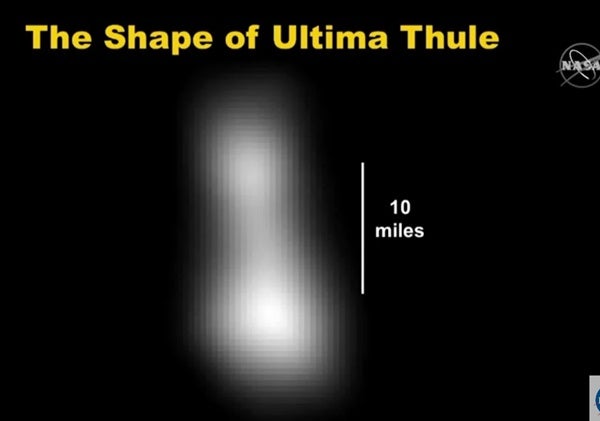New Horizons successfully “phoned home” at 10:28 a.m. EST, letting NASA scientists know all of its systems survived the flyby of Ultima Thule. The first real images will now slowly trickle in over the coming hours and days.
“We have a healthy spacecraft,” Mission Operations Manager, “MOM,” Alice Bowman announced to a crowd of cheering scientists Tuesday morning.
New Horizons, Phone Home
Not long after the stroke of midnight on New Year’s Day, as 2018 gave way to 2019, NASA’s New Horizons spacecraft flew by the far-out space rock Ultima Thule. At 12:33 am EST this morning, the craft passed within 2,200 miles (3,540 km) of the Kuiper Belt Object (KBO), formally known as 2014 MU69. This was the farthest object that any craft has ever visited.
Now, New Horizons will beam the first information and images from this close flyby back to Earth. However, seeing as the exploratory spacecraft is about four billion miles (6.6 billion km) from our home planet, this data takes a while to travel back to Earth. In fact, it takes more than six hours for radio signals carrying information from New Horizons to deliver the data to NASA’s Deep Space Network.
At 10:28 am EST today, New Horizons made its pre-programmed “phone home,” letting the mission team back on Earth know that the craft completed the flyby unharmed. This call didn’t include any information about the object, but later today the first science data and imagery of the far-out space rock will be available.
At 11:35 a.m. EST, NASA held a press conference to update the spacecraft status, including the latest images and data download schedule. The team released an image taken before the flyby while the spacecraft was still some one million miles from Ultima Thule.
“It’s a better pixelated blob than the day before,” said New Horizons Project Scientist Hal Weaver. The grainy image reveals Ultima Thule is shaped something like a spinning bowling pin.
The first science data taken during the flyby will arrive tonight. This will be followed by more scientific data and higher-resolution images over the next few hours and days. The very highest color images won’t arrive until February, but the team expects to have a good idea of what Ultima Thule looks like this week.
Overnight tonight, official say the first high-resolution science data should arrive and scientists will begin analyzing the information. An even better image should be released on January 2. New Horizons was set to take a total of 900 highest-resolution images throughout the flyby and the mission team will know in time how many of those images clearly show Ultima Thule. All in all, New Horizons will collect 50 gigabits of data, as compared to the 55 gigabits collected at Pluto.
“We’re going to start writing our first scientific paper next week,” said the Southwest Research Institute’s Alan Stern, the New Horizons team leader.
For those looking to keep up with the influx of science data and imagery, Johns Hopkins University Applied Physics Laboratory, which live-streamed coverage of the flyby, will continue to provide updates in press conferences which can be viewed here.










